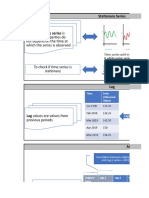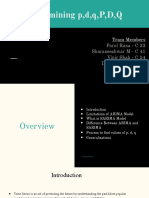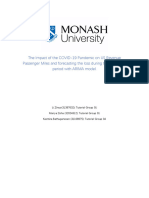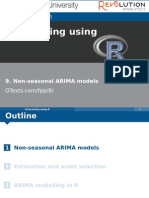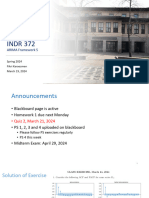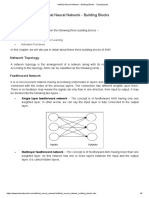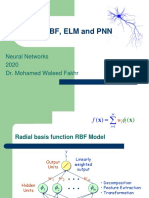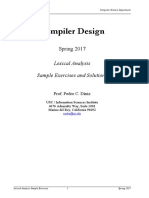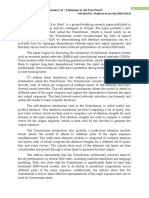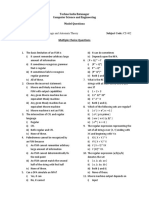Pure seasonal
models
ARIMA MODELS IN R
David Stoffer
Professor of Statistics at the University
of Pittsburgh
Pure Seasonal Models
Often collect data with a known seasonal component
Air Passengers (1 cycle every S = 12 months)
Johnson & Johnson Earnings (1 cycle every S = 4 quarters)
ARIMA MODELS IN R
Pure Seasonal Models
Consider pure seasonal models such as an SAR(P = 1)s=12
Xt = ΦXt−12 + Wt
ARIMA MODELS IN R
ACF and PACF of Pure Seasonal Models
SAR(P )s SM A(Q)s SARM A(P , Q)s
ACF* Tails off Cuts off lag QS Tails off
PACF* Cuts off lag PS Tails off Tails off
ARIMA MODELS IN R
Let's practice!
ARIMA MODELS IN R
Mixed seasonal
models
ARIMA MODELS IN R
David Stoffer
Professor of Statistics at the University
of Pittsburgh
Mixed Seasonal Model
Mixed model: SARIMA(p, d, q) × (P , D, Q)s model
Consider a SARIMA(0, 0, 1) × (1, 0, 0)12 model
Xt = ΦXt−12 + Wt + θWt−1
SAR(1): Value this month is related to last year's value Xt−12
MA(1): This month's value related to last month's shock Wt−1
ARIMA MODELS IN R
ACF and PACF of SARIMA(0,0,1) x (1,0,0) s=12
The ACF and PACF for this mixed model:
Xt = .8Xt−12 + Wt − .5Wt−1
ARIMA MODELS IN R
ACF and PACF of SARIMA(0,0,1) x (1,0,0) s=12
The ACF and PACF for this mixed model:
Xt = .8Xt−12 + Wt − .5Wt−1
ARIMA MODELS IN R
ACF and PACF of SARIMA(0,0,1) x (1,0,0) s=12
The ACF and PACF for this mixed model:
Xt = .8Xt−12 + Wt − .5Wt−1
ARIMA MODELS IN R
Seasonal Persistence
ARIMA MODELS IN R
Seasonal Persistence
ARIMA MODELS IN R
Seasonal Persistence
ARIMA MODELS IN R
Air Passengers
Monthly totals of international airline passengers, 1949-1960
ARIMA MODELS IN R
Air Passengers: ACF and PACF of ddlx
ARIMA MODELS IN R
Air Passengers: ACF and PACF of ddlx
Seasonal: ACF cutting off at lag 1s (s = 12); PACF tailing off at
lags 1s, 2s, 3s…
ARIMA MODELS IN R
Air Passengers: ACF and PACF of ddlx
Seasonal: ACF cutting off at lag 1s (s = 12); PACF tailing off at
lags 1s, 2s, 3s…
ARIMA MODELS IN R
Air Passengers: ACF and PACF of ddlx
Seasonal: ACF cutting off at lag 1s (s = 12); PACF tailing off at
lags 1s, 2s, 3s…
Non-Seasonal: ACF and PACF both tailing off
ARIMA MODELS IN R
Air Passengers
airpass_fit1 <- sarima(log(AirPassengers), p = 1,
d = 1, q = 1, P = 0,
D = 1, Q = 1, S = 12)
airpass_fit1$ttable
Estimate SE t.value p.value
ar1 0.1960 0.2475 0.7921 0.4296
ma1 -0.5784 0.2132 -2.7127 0.0075
sma1 -0.5643 0.0747 -7.5544 0.0000
airpass_fit2 <- sarima(log(AirPassengers), 0, 1, 1, 0, 1, 1, 12)
airpass_fit2$ttable
Estimate SE t.value p.value
ma1 -0.4018 0.0896 -4.4825 0
sma1 -0.5569 0.0731 -7.6190 0
ARIMA MODELS IN R
Air Passengers
ARIMA MODELS IN R
Let's practice!
ARIMA MODELS IN R
Forecasting
seasonal ARIMA
ARIMA MODELS IN R
David Stoffer
Professor of Statistics at the University
of Pittsburgh
Forecasting ARIMA Processes
Once model is chosen, forecasting is easy because the model
describes how the dynamics of the time series behave over
time
Simply continue the model dynamics into the future
In the astsa package, use sarima.for() for forecasting
ARIMA MODELS IN R
Forecasting Air Passengers
In the previous video, we decided that a
SARIMA(0, 1, 1) × (0, 1, 1)12 model was appropriate
sarima.for(log(AirPassengers), n.ahead = 24,
0, 1, 1, 0, 1, 1, 12)
ARIMA MODELS IN R
Let's practice!
ARIMA MODELS IN R
Congratulations!
ARIMA MODELS IN R
David Stoffer
Professor of Statistics at the University
of Pittsburgh
What you've learned
How to identify an ARMA model from data looking at ACF
and PACF
How to use integrated ARMA (ARIMA) models for
nonstationary time series
How to cope with seasonality
ARIMA MODELS IN R
Don't stop here!
astsa package
Other DataCamp courses in Time Series Analysis
ARIMA MODELS IN R
Thank you!
ARIMA MODELS IN R








